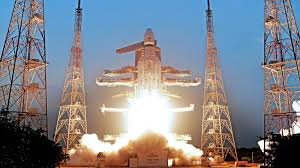ISRO Launches Heaviest-Ever Communication Satellite, Boosting India’s Maritime and Connectivity Capabilities
The Indian Space Research Organisation (ISRO) achieved another milestone on Wednesday with the successful launch of its heaviest-ever communication satellite, aimed at significantly enhancing India’s maritime surveillance, communication, and data connectivity capabilities.
The satellite, weighing nearly 6,200 kilograms, was launched aboard the Geosynchronous Satellite Launch Vehicle Mark-III (GSLV Mk-III) — India’s most powerful rocket — from the Satish Dhawan Space Centre in Sriharikota at 6:30 AM (IST).
With this successful mission, India has entered a new phase of advanced satellite communication technology, reinforcing its position as a global space power.
Mission Details: A Record-Breaking Launch
The latest launch marks one of ISRO’s most ambitious communication missions to date. Designated as GSAT-32, the satellite was placed into a geosynchronous transfer orbit (GTO) about 36,000 kilometers from Earth.
The GSLV Mk-III, also known as LVM-3, carried the satellite with a payload capacity exceeding 6 tonnes — the heaviest ever lifted by an Indian launch vehicle. After a precise 19-minute flight, the satellite was successfully injected into its intended orbit, drawing applause from mission control.
ISRO Chairman S. Somanath, addressing the media after the launch, said,
“This mission demonstrates India’s growing capability in building and deploying advanced heavy-lift satellites. The new communication satellite will play a critical role in strengthening our maritime security and national communication systems.”
Purpose and Capabilities of the Satellite
The newly launched communication satellite is designed to serve multiple national and strategic needs.
1. Enhanced Maritime Communication:
It will provide real-time data, voice, and video connectivity to ships and naval vessels operating in the Indian Ocean Region (IOR), a critical step in improving India’s maritime surveillance and disaster management systems.
2. Wider Broadband Coverage:
The satellite is equipped with Ku-band and C-band transponders, offering enhanced broadband internet coverage to remote islands, border regions, and rural areas where terrestrial networks remain weak.
3. Support for Disaster Management:
The satellite will aid emergency communication and coordination during natural disasters, such as cyclones, floods, and tsunamis, particularly in coastal states.
4. Defence and Strategic Communication:
It will also support defence communication networks, providing secure and high-bandwidth links between command centres, naval bases, and deployed units.
Technological Highlights
Built at ISRO’s U R Rao Satellite Centre (URSC) in Bengaluru, the satellite incorporates several state-of-the-art features:
- High-Power Transponders for uninterrupted communication links.
- Advanced Propulsion Systems for precise orbital positioning.
- Thermal Control Systems to ensure functionality in extreme space temperatures.
- Electric Propulsion Technology, reducing fuel load and extending operational lifespan.
This satellite represents India’s gradual shift towards next-generation communication systems, capable of supporting 5G connectivity, satellite-based internet, and remote sensing networks in coordination with other ISRO satellites.
Maritime and Strategic Significance
India’s vast coastline and exclusive economic zone (EEZ) span more than 2 million square kilometers. Maintaining communication coverage across these waters is vital for national security, navigation safety, and fisheries management.
The new satellite will support the Indian Navy, Coast Guard, and merchant shipping fleets, ensuring seamless connectivity even in the farthest stretches of the ocean.
Officials from the Ministry of Defence confirmed that the satellite will integrate with India’s Naval Communication Network (NCN) and enhance the nation’s Maritime Domain Awareness (MDA).
Experts believe the move strengthens India’s position in the Indo-Pacific region, aligning with strategic initiatives like the Sagarmala project and Digital India mission.
Global Context and Collaboration
The GSAT-32 mission also underscores India’s growing independence in space technology. While earlier communication satellites were launched aboard foreign launch vehicles such as Ariane-5 (ESA), ISRO’s successful use of its own GSLV Mk-III highlights technological self-reliance.
ISRO’s scientists collaborated with several private and public sector industries under the Make in India initiative to develop the satellite’s key components, including its propulsion systems, solar panels, and communication payloads.
This mission also strengthens India’s readiness for future space-based projects such as BharatNet satellite broadband, Gaganyaan (human spaceflight), and satellite internet constellations in partnership with Indian startups.
A Step Toward Next-Gen Connectivity
The successful launch marks a big step in bridging India’s digital divide. With over 65% of India’s population living in rural areas, satellite communication offers a scalable and cost-effective alternative to ground infrastructure.
By enabling high-speed connectivity for remote regions, the mission will support initiatives in tele-education, telemedicine, and digital governance, expanding the reach of essential services.
Furthermore, the new satellite will support the government’s vision of ‘Digital India’ and ‘Viksit Bharat 2047’, enabling robust internet connectivity for both civilian and defense networks.
Statements from ISRO and the Government
In a congratulatory post on X (formerly Twitter), Prime Minister Narendra Modi hailed the launch as a milestone in India’s technological journey:
“Proud of our scientists at ISRO for the successful launch of India’s heaviest communication satellite. This mission strengthens our communication systems and ensures maritime and national security. A giant step for #AatmanirbharBharat in space.”
Union Minister for Science and Technology Dr. Jitendra Singh also congratulated ISRO, emphasizing that the mission aligns with India’s goal of achieving complete space technology independence.
Future Missions Ahead
With the successful GSAT-32 launch, ISRO is now gearing up for several major missions, including:
- Gaganyaan (India’s first crewed space mission) in early 2026.
- Chandrayaan-4 for advanced lunar exploration.
- Aditya-L2 for solar observations.
- India’s first Low Earth Orbit (LEO) satellite constellation for high-speed communication.
The success of this mission further enhances ISRO’s credibility as one of the world’s most efficient and reliable space agencies, capable of delivering complex, high-impact missions at a fraction of global costs.
Strengthening India’s Space Power
The launch of India’s heaviest communication satellite marks more than just a technological success — it’s a symbol of national progress, self-reliance, and vision.
As the satellite begins its journey in orbit, it promises to transform India’s maritime operations, defense communication, and digital connectivity, bridging oceans and communities alike.
With each mission, ISRO continues to lift India’s aspirations higher — proving once again that the sky is not the limit, but just the beginning.













